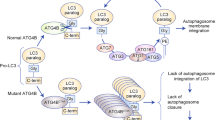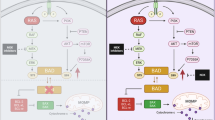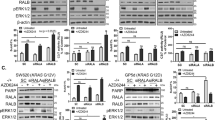Abstract
Pancreatic ductal adenocarcinoma (PDA) was responsible for ~ 44,000 deaths in the United States in 2018 and is the epitome of a recalcitrant cancer driven by a pharmacologically intractable oncoprotein, KRAS1,2,3,4. Downstream of KRAS, the RAF→MEK→ERK signaling pathway plays a central role in pancreatic carcinogenesis5. However, paradoxically, inhibition of this pathway has provided no clinical benefit to patients with PDA6. Here we show that inhibition of KRAS→RAF→MEK→ERK signaling elicits autophagy, a process of cellular recycling that protects PDA cells from the cytotoxic effects of KRAS pathway inhibition. Mechanistically, inhibition of MEK1/2 leads to activation of the LKB1→AMPK→ULK1 signaling axis, a key regulator of autophagy. Furthermore, combined inhibition of MEK1/2 plus autophagy displays synergistic anti-proliferative effects against PDA cell lines in vitro and promotes regression of xenografted patient-derived PDA tumors in mice. The observed effect of combination trametinib plus chloroquine was not restricted to PDA as other tumors, including patient-derived xenografts (PDX) of NRAS-mutated melanoma and BRAF-mutated colorectal cancer displayed similar responses. Finally, treatment of a patient with PDA with the combination of trametinib plus hydroxychloroquine resulted in a partial, but nonetheless striking disease response. These data suggest that this combination therapy may represent a novel strategy to target RAS-driven cancers.
This is a preview of subscription content, access via your institution
Access options
Access Nature and 54 other Nature Portfolio journals
Get Nature+, our best-value online-access subscription
$29.99 / 30 days
cancel any time
Subscribe to this journal
Receive 12 print issues and online access
$209.00 per year
only $17.42 per issue
Buy this article
- Purchase on Springer Link
- Instant access to full article PDF
Prices may be subject to local taxes which are calculated during checkout




Similar content being viewed by others
Data availability
The data that support the findings of this study are available from the corresponding author upon request.
Change history
27 March 2019
In the version of this article initially published, the label over the bottom schematic in Fig. 1a was “pH > 5.0”; it should have been “pH < 5.0”. Further, the original article misspelt the surname of Katrin P. Guillen as “Gullien”. These errors have been corrected in the print, PDF and HTML versions of the article.
References
Siegel, R. L., Miller, K. D. & Jemal, A. Cancer Statistics, 2017. CA Cancer J. Clin. 67, 7–30 (2017).
Li, D. et al. Pancreatic cancer. Lancet 363, 1049–1057 (2004).
Gao, J. et al. Integrative analysis of complex cancer genomics and clinical profiles using the cBioPortal. Sci. Signal. 6, pl1 (2013).
Cerami, E. et al. The cBio cancer genomics portal: an open platform for exploring multidimensional cancer genomics data. Cancer Discov. 2, 401–404 (2012).
Collisson, E. A. et al. A central role for RAF→MEK→ERK signaling in the genesis of pancreatic ductal adenocarcinoma. Cancer Discov. 2, 685–693 (2012).
Infante, J. R. et al. A randomised, double-blind, placebo-controlled trial of trametinib, an oral MEK inhibitor, in combination with gemcitabine for patients with untreated metastatic adenocarcinoma of the pancreas. Eur. J. Cancer 50, 2072–2081 (2014).
Kimura, S., Noda, T. & Yoshimori, T. Dissection of the autophagosome maturation process by a novel reporter protein, tandem fluorescent-tagged LC3. Autophagy 3, 452–460 (2007).
Gump, J. M. & Thorburn, A. Sorting cells for basal and induced autophagic flux by quantitative ratiometric flow cytometry. Autophagy 10, 1327–1334 (2014).
Klionsky, D. J. et al. Guidelines for the use and interpretation of assays for monitoring autophagy (3rd edition). Autophagy 12, 1–222 (2016).
Ronan, B. et al. A highly potent and selective Vps34 inhibitor alters vesicle trafficking and autophagy. Nat. Chem. Biol. 10, 1013–1019 (2014).
Patricelli, M. P. et al. Selective Inhibition of Oncogenic KRAS Output with Small Molecules Targeting the Inactive State. Cancer Discov. 6, 316–329 (2016).
Gilmartin, A. G. et al. GSK1120212 (JTP-74057) is an inhibitor of MEK activity and activation with favorable pharmacokinetic properties for sustained in vivo pathway inhibition. Clin. Cancer Res. 17, 989–1000 (2011).
Rice, K. D. et al. Novel Carboxamide-Based Allosteric MEK Inhibitors: Discovery and Optimization Efforts toward XL518 (GDC-0973). ACS Med. Chem. Lett. 3, 416–421 (2012).
Morris, E. J. et al. Discovery of a novel ERK inhibitor with activity in models of acquired resistance to BRAF and MEK inhibitors. Cancer Discov. 3, 742–750 (2013).
Lito, P. et al. Allele-specific inhibitors inactivate mutant KRAS G12C by a trapping mechanism. Science 351, 604–608 (2016).
Zheng, B. et al. Oncogenic B-RAF negatively regulates the tumor suppressor LKB1 to promote melanoma cell proliferation. Mol. Cell 33, 237–247 (2009).
Kim, J. et al. AMPK and mTOR regulate autophagy through direct phosphorylation of Ulk1. Nat. Cell Biol. 13, 132–141 (2011).
Egan, D. F. et al. Phosphorylation of ULK1 (hATG1) by AMP-activated protein kinase connects energy sensing to mitophagy. Science 331, 456–461 (2011).
Mihaylova, M. M. & Shaw, R. J. The AMPK signalling pathway coordinates cell growth, autophagy and metabolism. Nat. Cell Biol. 13, 1016–1023 (2011).
Chou, T. C. Drug combination studies and their synergy quantification using the Chou-Talalay method. Cancer Res. 70, 440–446 (2010).
Vessoni, A. T. et al. Chloroquine-induced glioma cells death is associated with mitochondrial membrane potential loss, but not oxidative stress. Free Radic. Biol. Med. 90, 91–100 (2016).
Boya, P. et al. Mitochondrial membrane permeabilization is a critical step of lysosome-initiated apoptosis induced by hydroxychloroquine. Oncogene 22, 3927–3936 (2003).
Fujita, N. et al. An Atg4B mutant hampers the lipidation of LC3 paralogues and causes defects in autophagosome closure. Mol. Biol. Cell 19, 4651–4659 (2008).
Yang, A. et al. Autophagy Sustains Pancreatic Cancer Growth through Both Cell-Autonomous and Nonautonomous Mechanisms. Cancer Discov. 8, 276–287 (2018).
Awasthi, N. et al. Comparative benefits of Nab-paclitaxel over gemcitabine or polysorbate-based docetaxel in experimental pancreatic cancer. Carcinogenesis 34, 2361–2369 (2013).
Young, N. P., Crowley, D. & Jacks, T. Uncoupling cancer mutations reveals critical timing of p53 loss in sarcomagenesis. Cancer Res. 71, 4040–4047 (2011).
Levy, J. M. M., Towers, C. G. & Thorburn, A. Targeting autophagy in cancer. Nat. Rev. Cancer 17, 528–542 (2017).
Levy, J. M. et al. Autophagy inhibition improves chemosensitivity in BRAF(V600E) brain tumors. Cancer Discov. 4, 773–780 (2014).
Mulcahy Levy, J. M. et al. Autophagy inhibition overcomes multiple mechanisms of resistance to BRAF inhibition in brain tumors. eLife 6, e19671 (2017).
Bryant, K. L. et al. Combination of ERK and autophagy inhibition as a treatment approach for pancreatic cancer. Nat. Med. https://doi.org/10.1038/s41591-019-0368-8 (2019).
Ma, X. H. et al. Targeting ER stress-induced autophagy overcomes BRAF inhibitor resistance in melanoma. J. Clin. Invest. 124, 1406–1417 (2014).
Eng, C. H. et al. Macroautophagy is dispensable for growth of KRAS mutant tumors and chloroquine efficacy. Proc. Natl Acad. Sci USA 113, 182–187 (2016).
Rosenfeldt, M. T. et al. p53 status determines the role of autophagy in pancreatic tumour development. Nature 504, 296–300 (2013).
Sousa, C. M. et al. Pancreatic stellate cells support tumour metabolism through autophagic alanine secretion. Nature 536, 479–483 (2016).
Poillet-Perez, L. et al. Autophagy maintains tumour growth through circulating arginine. Nature 563, 569–573 (2018).
Honda, A. et al. Potent, Selective, and Orally Bioavailable Inhibitors of VPS34 Provide Chemical Tools to Modulate Autophagy in Vivo. ACS Med. Chem. Lett. 7, 72–76 (2016).
Egan, D. F. et al. Small Molecule Inhibition of the Autophagy Kinase ULK1 and Identification of ULK1 Substrates. Mol. Cell 59, 285–297 (2015).
Kim, K. B. et al. Phase II study of the MEK1/MEK2 inhibitor Trametinib in patients with metastatic BRAF-mutant cutaneous melanoma previously treated with or without a BRAF inhibitor. J. Clin. Oncol. 31, 482–489 (2013).
White, N. J. The treatment of malaria. N. Engl. J. Med. 335, 800–806 (1996).
Ben-Zvi, I. et al. Hydroxychloroquine: from malaria to autoimmunity. Clin. Rev. Allergy Immunol. 42, 145–153 (2012).
Di Veroli, G. Y. et al. Combenefit: an interactive platform for the analysis and visualization of drug combinations. Bioinformatics 32, 2866–2868 (2016).
Acknowledgements
We dedicate this work to the memory of our patient and his family, whose courage continues to inspire us to further improve the diagnosis and treatment of pancreatic cancer. We thank the members of the McMahon Lab for their support, advice, guidance, comments and discussions during the course of this work. Additionally we thank I. Garrido-Laguna (HCI/Univ. of Utah), M. Tempero, E. Collisson and F. McCormick (U.C. San Francisco), E. White (Rutgers University), D. Tuveson (Cold Spring Harbor), and K. Olive (Columbia) for advice and guidance, J. Mulcahy-Levy and A. Thorburn (U.C. Denver) for inspiration, advice, guidance and reagents, H. Land (University of Rochester Medical Center) and K. Shokat (UCSF) for providing reagents, NCI Patient-Derived Models Repository for supplying the NCI-516677 NRAS-mutated melanoma PDX, K. Owings, D. Lum and the HCI Preclinical Research Resource for assistance with tumor xenografts and drug treatments and M. Silvis for assistance with drug dosing. C.K. & M.M. wish to acknowledge the collegiality of K. Bryant and C. Der (University of North Carolina, Chapel Hill) for ongoing discussions and for sharing data in advance of publication. M.M. acknowledges financial support from the National Cancer Institute (R01-CA176839, R01-CA131261 & P30-CA042014), the Pancreatic Cancer Collective, Melanoma Research Alliance, Five for the Fight, and the Huntsman Cancer Foundation. E.L.S. was supported in part by a Career Award for Medical Scientists from the Burroughs Wellcome Fund, a V Scholar Award, the Huntsman Cancer Foundation, and the NIH (R01CA212415). B.E.W. acknowledges support from the National Cancer Institute and DoD (U54CA224076 and W81XWH1410417). A.L.W. acknowledges support from the Huntsman Cancer Foundation. C.G.K acknowledges support from the Huntsman Cancer Foundation. A.M.B. acknowledges support from Fondation pour la Recherché Medicale (FDM20150633361) and Societe Francaise de Dermatologie.
Author information
Authors and Affiliations
Contributions
C.G.K. and M.M designed all experiments. C.G.K., S.A.C., A.M.B., K.P.G., M.F., A.T. and S.S.S. performed in vitro and in vivo experiments and collected data. J.T.Y. and L.D.B. designed, performed and analyzed in vivo FDG-PET/MRI/CT imaging studies. J.E.S., M.T.S., D.H.L, A.L.W., and C.L.S established, maintained and provided PDX mouse models. B.E.W. and E.L.S supervised experiments performed by K.P.G. and S.A.C., respectively. C.G.K., J.R.W., G.W.G., C.C.C., K.M.R., and S.L.C. provided patient care. K.E.A. assisted with pathologic analysis of samples. C.G.K. and M.M. analyzed data, prepared the manuscript and guided the manuscript through review.
Corresponding author
Ethics declarations
Competing interests
M.M. served on external advisory boards for Novartis (June 2017), Genentech (December 2017) and Merck (June 2018). M.M. is the recipient of research funding from Pfizer, through a grant peer-reviewed, co-funded and awarded by the Melanoma Research Alliance.
Additional information
Publisher’s note: Springer Nature remains neutral with regard to jurisdictional claims in published maps and institutional affiliations.
Extended data
Extended Data Fig. 1 Flow cytometry analysis of autophagic flux reporter with autophagy inhibitors and inducers.
a-e: Autophagic flux was assessed by flow cytometry in Mia-PaCa2AFR cells following 48 h treatment with control, chloroquine (CQ), SAR-405, temsirolimus, or trametinib. Experiments were repeated three times with similar results. f: Autophagic flux was assessed by fluorescent imaging in Mia-PaCa2AFR cells following 48 h treatment with control, chloroquine (CQ), VPS34i (SAR-405), or trametinib. Experiments were repeated three times with similar results.
Extended Data Fig. 2 Inhibition of RAS→RAF→MEK→ERK signaling pathway induces autophagic flux (AF) as seen by p62 degradation and LC3 conversion in pancreatic cancer cells.
a & b: Cell lysates prepared from Mia-PaCa2 (a) or BxPC3 (b) cells treated with 0.1–100 nM of trametinib for 48 h were analyzed by immunoblotting for the phosphorylation (p) or total (t) abundance of ERK1/2, p62, LC3, or actin as indicated. Experiments were repeated three times with similar results. c: Cell lysates prepared from Mia-PaCa2 cells treated with ARS-853 (KRASG12Ci), SCH772984 (ERKi), or cobimetinib (MEKi) for 48 h were analyzed by immunoblotting for the phosphorylation (p) or total (t) abundance of ERK1/2, p62, LC3, or actin as indicated. Experiments were repeated three times with similar results. d: Cell lysates prepared from Mia-PaCa2AFR cells transiently expressing exogenous ULK1WT, ULKM92A (dominant negative), AMPKWT, or AMPKK45R (dominant negative) were analyzed by immunoblotting for ULK1, AMPK, or actin as indicated. Experiments were repeated three times with similar results. e: Cell lysates prepared from Mia-PaCa2AFR cells lentivirally transduced with shRNAs targeting LKB1 or scrambled control were analyzed by immunoblotting for LKB1 or actin as indicated. Experiments were repeated three times with similar results.
Extended Data Fig. 3 Trametinib and chloroquine are synergistically cytotoxic in vitro.
Mia-PaCa2 cells, BxPC3 and PDX220 cells were treated for 48–96 as indicated with trametinib and chloroquine and analyzed for cell viability by ATPlite assay. Synergy scores were generated utilizing Combenefit Software. Experiments were repeated four times with similar results.
Extended Data Fig. 4 Treatment of pancreatic tumors with trametinib and chloroquine results in decreased pERK and increased p62 abundance respectively.
Representative images of immunohistochemical analysis of sections of PDX 227 tumors that were treated with 1. vehicle (Control), 2. trametinib; 3. chloroquine or; 4. the combination of both agents. Sections were stained with H&E or with antisera against pERK1/2 or p62 as indicated. Experiments were repeated four times with similar results. Scale bar is 500 μM located in the bottom right of the upper left panel and is consistent for all images.
Extended Data Fig. 5 Treatment of orthopically xenografted pancreatic tumors with trametinib and hydroxychloroquine demonstrates regression consistent with subcutaneous xenografts.
a: PDX220 tumors were orthotopically transplanted and after 3 weeks were imaged via FDG-PET/CT for baseline. They were then treated with trametinib, hydroxychloroquine or trametinib plus hydroxychloroquine for 2 weeks prior to re-imaging. n = 3 for control; n = 2 for HCQ; n = 3 for trametinib; n = 2 for trametinib + hydroxychloroquine. b & c: Quantification of total lesion glycolysis (b) and % change (c) for individual tumors within each treatment group.
Extended Data Fig. 6 Regression of established NRAS driven melanoma tumors by combined inhibition of MEK1/2 plus chloroquine.
a. The growth of an NRAS-mutated melanoma (NCI515677) PDX was assessed over 21 days in mice treated with: 1. vehicle (Control), 2. trametinib (1 mg/kg), 3. chloroquine (25 mg/kg) or; 4. the combination of both agents at the aforementioned doses as indicated. n = 4 for all treatment groups except combination of both agents n = 5. Center values are the mean; statistical testing was performed by two-sided t-test; ***p < 0.001 vs. control; tttp < 0.001 vs. trametinib. Error bars represent SD. b-e. The percentage weight change of HCI-Mel002 NRAS-mutated PDX was assessed over 21 days in mice treated with: b. vehicle (Control), c. trametinib (1 mg/kg), d. chloroquine (50 mg/kg) or; e. the combination of both agents at the aforementioned doses as indicated. However, side-effects of facial rash and hair loss were noted.
Extended Data Fig. 7 Lack of autophagy induction by MEK1/2 inhibition results in resistance to combined trametinib and chloroquine treatment.
a: Cell lysates prepared from two suitably manipulated KRASG12D/TP53Null mouse lung cancer-derived cell lines, SC196 or SC274 treated with 100 nM of trametinib were analyzed by immunoblotting for the phosphorylation (p) or total (t) abundance of ERK1/2, p62, LC3, or actin as indicated. Experiments were repeated three times with similar results. b: SC196 and SC274 KRASG12D/TP53Null mouse lung cancer cells were treated for 48 h respectively with trametinib and chloroquine and analyzed for cell viability by ATPlite assay. Synergy scores were generated utilizing Combenefit Software. Experiments were repeated four times with similar results. c & d: Autophagic flux was measured in SC196AFR (c) or SC274AFR (d) following treatment with 0.1–1000 nM trametinib for 48 h. n = 3; center values are the mean; statistical testing was performed by two-sided t-test of control high (red) versus experimental high; ***p < 0.001 vs. control. Error bars represent SD. e & f: The growth of SC196 (e) or SC274 (f) KRASG12D/TP53Null mouse lung cancer derived tumors in xenografted mice treated with: 1. vehicle (Control), 2. trametinib (1 mg/kg), 3. chloroquine (50 mg/kg) or; 4. the combination of both agents was assessed over ~ 15 days as indicated. n = 10 for all treatment groups. Center values are the mean; statistical testing was performed by two-sided t-test;***p < 0.001 vs. control; tttp < 0.001 vs. trametinib. Error bars represent SD.
Supplementary information
Source data
Source Data Fig. 1
Statistical Source Data
Source Data Fig. 1
Unprocessed Western Blots
Source Data Fig. 2
Statistical Source Data
Source Data Fig. 3
Statistical Source Data
Source Data Fig. 3
Unprocessed Western Blots
Source Data Extended Data Fig. 2
Unprocessed Western Blots.
Source Data Extended Data Fig. 6
Statistical Source Data
Source Data Extended Data Fig. 7
Statistical Source Data
Source Data Extended Data Fig. 7
Unprocessed Western Blots
Rights and permissions
About this article
Cite this article
Kinsey, C.G., Camolotto, S.A., Boespflug, A.M. et al. Protective autophagy elicited by RAF→MEK→ERK inhibition suggests a treatment strategy for RAS-driven cancers. Nat Med 25, 620–627 (2019). https://doi.org/10.1038/s41591-019-0367-9
Received:
Accepted:
Published:
Issue Date:
DOI: https://doi.org/10.1038/s41591-019-0367-9
This article is cited by
-
Lysosomes as coordinators of cellular catabolism, metabolic signalling and organ physiology
Nature Reviews Molecular Cell Biology (2024)
-
Combinatorial strategies to target RAS-driven cancers
Nature Reviews Cancer (2024)
-
Targeting KRAS in cancer
Nature Medicine (2024)
-
CDK4/6 inhibition sensitizes MEK inhibition by inhibiting cell cycle and proliferation in pancreatic ductal adenocarcinoma
Scientific Reports (2024)
-
New clinical trial design in precision medicine: discovery, development and direction
Signal Transduction and Targeted Therapy (2024)



